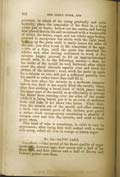Ingredients :—One pound of the finest quality of sugar (pounded), fourteen eggs, four ounces and a half of the finest flour, and four ounces and a half of Brown and Polson's patent corn-flour.
First, separate the yolks from the whites of eggs, taking care not to drop the least portion of the yolks into the whites, as any mixture of these renders it impossible to whisk the whites firm. The yolks must be put into a kitchen-basin, and the whites into an egg-bowl, to be kept in a cool place until used; add the sugar to the yolks; throw in as much salt as will stand on a sixpence, and either some vanilla, lemon, or orange-sugar, or else, a few drops of any kind of essence, such as orange, lemon, orange-flowers, vanilla, or bitter-almonds. Work these together with a wooden spoon, until the whole presents the appearance of a thick creamy batter. The whites must now be whisked into a firm substantial snowy froth; and while this is going on, let both the flours be well mixed in with the batter. As soon as the whites are satisfactorily-whisked, proceed to mix them in with the batter: they must be added in small quantities at first, until it has become smoothly diluted; the whole of what remains should then be added, and gently, yet thoroughly, mixed. The batter thus prepared must now be gently poured into a mould previously got ready for the purpose in the following manner :—about one pound, of beef or veal-suet should be first chopped very fine, then melted down in a stewpan; after it has been strained through a napkin, pour this into the mould, turn it round in all directions, so that the fat may touch all the angles and recesses; it must then be poured out, and the mould should be turned upside-down on a plate, and allowed to stand in a warm place for a few minutes that the fat may be entirely drained off. About one pound of the finest-sifted sugar should now be immediately put in the mould, and shaken, about in it, in order that it may effectually cover the whole of the inside of the mould with a perfectly sinooth white surface or coating. Care must be taken to avoid leaving a greater quantity of fat adhering to the sides of the mould than is positively necessary; for, if there be too thick a coating of sugar in the mould, the Savoy cake will be more difficult to bake of a light colour; the heat of the oven being liable to partially calcine the sugar, and thus darken its hue, and spoil its beauty.
When the Savoy cake is ready to be baked, tie a broad band of paper (folded in three) round the base, and put a few wood-ashes on the baking-sheet, previously to placing the cake on it before putting it in the oven, which must be of very moderate heat; particular care must be taken to keep it closed as much as possible while the cake is baking, and also not to increase its temperature afterwards: this may be easily avoided if the oven be substantially built; by its being properly heated at first, it will then retain for some time an even temperature.
It is impossible to determine the exact length of time that this, or indeed any other cake should remain in the oven before it is done; this will mainly depend upon the construction of the oven, and partly on the necessity there may be for occasionally opening it during the process of baking the cake. The best way to ascertain whether the cake is done, is to run a wooden skewer down the centre, and if, when withdrawn, the skewer is dry, and free from any portion of the cake in an unbaked state, it will be safe to turn it out of the mould: it should then be of a light colour and smooth surface.
Note.—Savoy cakes may also be made by using twelve, sixteen, or even twenty eggs to one pound of sugar; but when a cake of large size is required, the proportions must be at the rate of twelve, fourteen, or at the utmost sixteen eggs to one pound of sugar: even in the latter case, such batter would not prove successful where four pounds are required to fill one mould. Savoy-cake batter, made in the proportion of sixteen or twenty eggs to one pound of sugar, is best adapted for small sponge-cakes, finger-biscuits, drops, &c.The whites must be whisked slowly at first, increasing the motion of the hand gradually until it reaches the greatest possible speed; the motion of the whisk must be kept up at this rate until the whites are become sufficiently firm, when they must be instantly mixed with the batter, otherwise they are liable, by partial decomposition, to lose their consistency.
